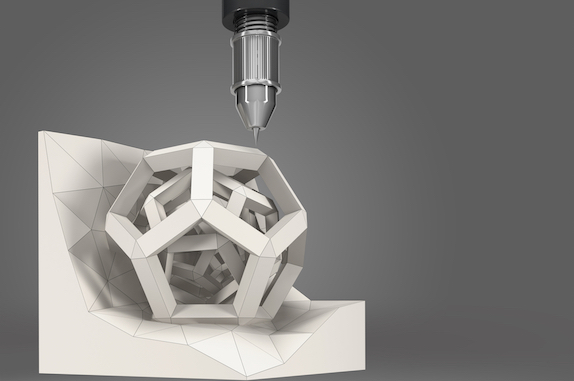3D printing, or additive manufacturing, has become an enabling technology in many fields, including applications in traditional chemical engineering process (developing internals for process plant equipment), as well as emerging areas such as bioengineering (tissue scaffolding). This session will offer an insight into the opportunity in 3D printing and where technology advances are headed.
This session will feature speakers from various sectors who are working with 3D Printing technology. Some possible topics include an overview of 3D printing technology, cutting-edge research and industrial applications.
In particular, examples of cutting-edge research in 3D printing technology include advanced materials and process improvement. Industrial applications may include printing equipment parts, 3D printed drugs and CO2 capture technology.
Featured Speakers:
- Joseph DeSimone, Carbon, The University of North Carolina at Chapel Hill, North Carolina State University
- Christopher Spadaccini, Lawrence Livermore National Laboratory
- Steve Wright, Eastman Chemical Company
- Timothy Weber, HP Inc.
Presentations:
Advances in 3D Manufacturing
Joseph M. DeSimone, CEO and Co-founder, Carbon, Chancellor’s Eminent Professor of Chemistry, The University of North Carolina at Chapel Hill; William R. Kenan Jr. Distinguished Professor of Chemical Engineering at North Carolina State University and of Chemistry at The University of North Carolina at Chapel Hill
3D printing has struggled to deliver on its promise to transform manufacturing. Prints take forever, parts are mechanically weak, and material choices are far too limited. In this talk I will update a breakthrough technology called Continuous Liquid Interface Production (CLIP) that grows parts instead of printing them layer by layer. CLIP allows businesses to produce commercial quality parts at game-changing speeds, creating a clear path to 3D manufacturing.
Additive Manufacturing and Architected Materials
Christopher Spadaccini, Director, Center for Engineered Materials, Manufacturing and Optimization, Lawrence Livermore National Laboratory
Material properties are governed by the chemical composition and spatial arrangement of constituent elements at multiple length-scales. This fundamentally limits material properties with respect to each other creating trade-offs when selecting materials for specific applications. For example, strength and density are inherently linked so that, in general, the more dense the material, the stronger it is in bulk form. We are combining advanced microstructural design, using flexure and screw theory as well as topology optimization, with advanced additive micro- and nanomanufacturing techniques to create new material systems with previously unachievable property combinations – mechanical metamaterials. The performance of these materials is fundamentally controlled by geometry at multiple length-scales rather than chemical composition. We have demonstrated designer properties of these mechanical metamaterials in polymers, metals, ceramics and combinations thereof. Properties include ultra-stiff lightweight materials, negative stiffness, and negative thermal expansion. Our additive micro-manufacturing techniques include Projection Microstereolithography (PSL), Direct Ink Writing (DIW), and Electrophoretic Deposition (EPD). These tools are capable of generating the designed structures which are highly three-dimensional micro- and nano-scale architectures with multiple constituent materials in the same structure.
Additive Manufacturing/3D Printing from a Polymer Materials Manufacturer’s Perspective
Steve Wright, Technology Fellow, Eastman Chemical Company
Eastman Chemical Company is a large, multinational polymer materials manufacturer currently exploring new materials for additive manufacturing (AM) in the fused filament fabrication (FFF)/fused deposition modeling (FDM) and laser and infrared-based powder sintering areas. When examining 3D printing, many similarities to the industrial development/build-out of injection molding can be found. Both techniques started with rudimentary equipment and, especially, limited materials that hindered true large-scale manufacturing market activation. While it took the dire manufacturing needs of a world war to activate new injection molding systems and polymer materials, modern societal and market drivers such as increased productivity, local production, just-in-time inventory, and individualization are driving additive manufacturing forward. After decades of relatively closed hardware and materials options, open materials approaches by major new 3D printer makers coupled with powerful design-oriented software are finally delivering the tools to rapidly boost end users past the so-called “hype phase” into true manufacturing-scale sectors. I will talk about Eastman’s efforts to commercialize our materials into the 3D printing space, the upcoming resurgence of FFF printing, why massive parallel AM printing might eventually meet (or even beat) injection molding process speeds, the need to take AM truly to a continuous process, and how we see previously fragmented market areas beginning to focus on tooling, molding, and more personally, unmet needs in sectors such as prosthetics. While 3D printers may not end up in every home, there are solid, new businesses with additive manufacturing as their core just around the corner!
HP’s Jet Fusion 3D Printing Technology: Enabling the Next Industrial Revolution
Timothy L. Weber, Global Head of 3D Materials & Advanced Applications, HP Inc.
In 2014 Hewlett-Packard announced the development and commercialization of an innovative 3D printing technology that promised to set new standards for performance, quality, reliability and low TCO. HP’s Multi Jet Fusion™ (MJF) technology achieves its breakthrough performance by leveraging the company’s 30+ year history of innovation and market leadership in imaging and digital printing. This presentation will provide an introduction to a new-to-the-world digital fabrication technology that makes it possible to design and print three-dimensional objects that possess both precise geometric and functional characteristics. The MJF technology will radically change the way engineers and designers prototype and produce functional parts and the blending of HP’s MJF 3D printing technology with digital materials design creates a new fabrication paradigm - a paradigm that enables innovation in both form and function.


